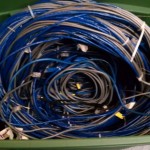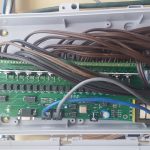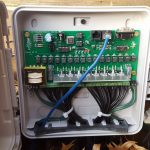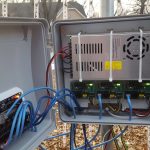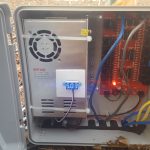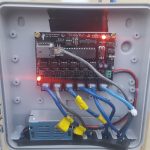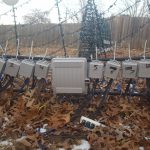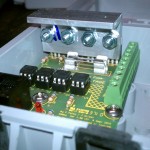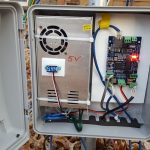- Cat 5e Cable, Almost 1/2 Mile in Use
- Ren SS24
- Ren SS16
- 3 PX-1, Bridge, and PS
- Ren48LSD and Power Supply
- Bridge
- Ren 64 and SSRs
- SSRez 110V Solid State Relay
- Pixlite 4
Updated for 2019
Our light show consists of just over 45k lights, both LED string lights and addressable Pixels. Controlling the lights takes a handful of devices:
–The show PC. This computer runs a software called xLights (https://xlights.org/) which is used to produce the actual light sequences. These sequences can take anywhere from 2 to 4 hours per song to complete, and more if you are picky like me 🙂 The newer software options definitely make life a little easier, and give more options for display effects.
–The Bridge. The bridge is a network device that takes all of the sequence data produced by the show pc and divides it up and sends it out to separate areas of the display. It also controls channel assignments and baud rates. I currently have 5 bridges in use. These send data out to my controllers, as well as info to about a dozen small boards called pixel extenders, for pixel control.
–The controllers. This year I have over 15 separate controllers in use. There are a variety, including: Renard 64XC5, Renard SS24, Renard SS16, Renard SS8, Renard Renzilla 96, Renard 48LSD, Renard PX-1, and a Pixlite 4 pixel controller. The Renard controllers are all hand built here, then programmed and set for use. Other than the PX-1 and Pixlite, the number in the controller name generally reflects the number of channels unit is capable of controlling. The PX-1 is a small pixel controller that can control up to 256 pixels. The Pixlite can control over 2700 pixels. All told, the show will have almost 20k channels this year.
–The Relays. I have a total of 48 four channel Solid State Relays in use. I use a combination of the SSRez and the Dirkcheap SSRs. These work with the Renard 64XC5 and Renzilla 96 to control the power going to light strings. The Renard SS controllers have this switching function built in.
–Tune To Sign. Our Tune-To sign at the end of the drive consists of several P10 pixel panels being driven by a Raspberry Pi3 microcomputer with an adapter for the P10 cabling.
